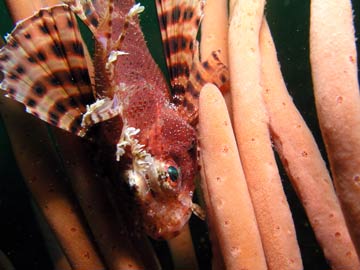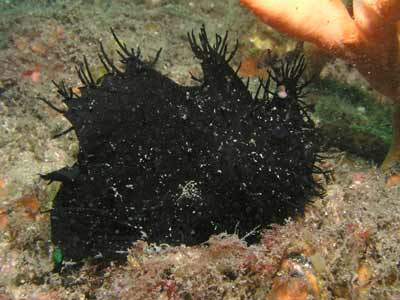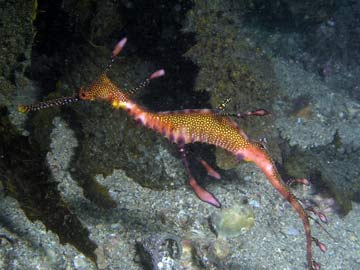Michael McFadyen's Scuba Diving - La Perouse Point
 |
A satellite photograph of La Perouse
The dive is the whole of the top left part of the land
Entry is bottom of this section and exit is the gap top left |
The history of Botany Bay goes back thousands, if not tens of thousands, of years. Prior to the visit by the first white men 1770, Botany Bay was already home to a number of Aboriginal tribes, Kameygal and Gweagal. One of reasons the Kooris thrived here was the abundance of marine life present in and around the Bay.
In 29 April 1770, Lieutenant James Cook, R.N., in HM Bark Endeavour entered Botany Bay and stepped ashore at Kurnell. Cook and his crew, including the famous scientist Sir Joseph Banks, explored the area of the bay and first named it Stingray Harbour because of the large number of rays they caught here. Cook and his crew stayed eight days and then headed north. He later renamed it Botany Bay due to the vast array of new flora and fauna that Banks and his assistant, Solander, found here.
Europeans were not to visit Botany Bay for another 18 years, but in January 1788 two separate European fleets visited the Bay within days of each other. The first to enter was the First Fleet under the command of Captain Arthur Phillip of the Royal Navy on 18 January 1788. He stayed until the morning of 26 January when he moved his fleet to Port Jackson (later called Sydney Harbour).
On 26 January while sailing the short distance from Botany Bay to Sydney Harbour, Captain Phillip sighted the French navigator Jean-Francois de Galaup, Comte de Laperouse off the coast in his ships La Broussole and L'Astrolobe. Later that day, Laperouse entered Botany Bay. He stayed almost 6 weeks and departed on 10 March 1788. Nothing further was ever heard of Laperouse and his men until 1827 when an Irish trader and adventurer, Captain Peter Dillion, heard from islanders about a wreck 40 years previously on the island of Vanikoro in the Solomon Islands. In the 1950s, Reese Discombe, a New Zealander, discovered the remains of one of the ships confirming Laperouse's fate. Of interest is the fact that Discombe also was one of the pioneer divers on the wreck of the SS President Coolidge in Vaunuatu.
Luckily for history, Laperouse had entrusted to Captain Phillip a copy of his logbook which he sent to Paris via London. This became our only knowledge of that part of his trip until he came to Botany Bay. Items of the equipment carried by the expedition and pieces of the ships can now be seen in the Laperouse Museum in the old Cable Station in the suburb of La Perouse on the Botany Bay shore. A replica of an anchor from L'Astrolobe is also on display at the Laperouse Monument and nearby is the grave of Pere Receveur, a Catholic priest who died on 17 February 1788 from injuries received earlier in the voyage.
One of the results from Laperouse's visit to Botany Bay is the fact the the suburb where he stayed has been called La Perouse (yes, a slightly different spelling) and the beach on the western side of the suburb is called Frenchmans Bay.
 |  |
| Some of the sponges on the rocks off the main reef | An overhang about a third along the reef |
La Perouse has some of the best diving in Sydney and is certainly the most popular location for diving in Sydney, if not New South Wales. Bare Island is located here and there are many different dives you can do around the island. Other places you can dive are the mainland either side of the bridge to the island. This article is about diving the western side of La Perouse. This is basically the section of mainland between the western side of the bridge and Frenchmans Bay, although you are unlikely to be able to cover the whole section of this reef (for reasons I will point out later). I have called this La Perouse Point, although as far as I know (and I have lived in the area or dived La Perouse since 1960) it does not have a proper name. Note that in mid-2006 Fisheries referred to the small bay as Astrolobe Bay in a press release about the sinking of some fish attraction devices, but again, I can find no legal basis for this name.
To do this dive, I would suggest doing it as a "drift" dive, even though you might not have any current (caused by the tide). In any case, the tides seem to flow in one direction on one part of the dive and then the opposite direction at the other end of the dive. Despite this, the tidal flow is never too strong to cause a problem. However, for visibility reasons, I would suggest you should try to do on an incoming or high tide.
The best place to start is just to the west of Bare Island Bridge. Park at almost the eastern end of the right angle parking to the west of the normal Bare Island parking spot. There is an excellent entry spot at the west side of the small bay below you to enter the water.
Gear up and walk through the break in the armco fencing and then across the grassed area down onto the rock platform. Get in at whichever of the flat rock spots is best considering the tide (note, as mentioned, you should do this dive on an incoming tide if possible). Once in the water, head south till you drop to the sand at about eight metres. Turn right and follow the reef edge to the west. Straight away you should see some sea dragons. The reef edge is a wall about two metres high. The depth drops a couple of metres to 10 metres before coming back up to eight metres.
 |  |
| A dwarf firefish, one of a number seen here | Blue green nudibranch seen here |
Along the way there are some boulders off the reef. These are worth examining as you can see some interesting things like firefish and nice nudibranches. On a lot of these boulders there is the same weed/algae that you see over at Bare Island that houses pygmy pipehorses. If you look carefully you may see some. We have seen them here, but not as many as at Bare Island.
A short distance west there are a few small overhangs and a couple of small canyons, mostly formed by very large boulders off the wall. You can swim through these and one of them seems more like a arch. Keep a look out for blue ringed octopus as you go, as well as pineapplefish (knightfish) which may be seen under the overhangs. You may also see sea horses on the sea squirts or sponges. Also look for red indianfish on the sand or near the sponges. The sponge and sea squirts are very colourful along this section of the dive.
The depth increases to almost 11 and then 12 metres as you go. After 20 minutes you will be still heading west but soon the direction will change to north-west and then north. At the same time the depth drops further to almost 13 metres. The wall here is not as prominent. When you start heading north-west, you are off La Perouse Point. However, despite what you may think, you are quite a way from the shore, perhaps 100 metres or more and are in fact south-west of the point.
 |  |
Two photographs of a black anglerfish we saw on the western end of this site
It is very hard to get a good shot as there was a lot of sand floating around and they move a bit
In the photo at left it is almost facing head on - in the one at right its head is on the right | |
As you head in a roughly northern direction, you will start coming up. It will be about 30 to 35 minutes by now. In some spots the wall comes back very prominent and there are also some small overhangs. There are often very large cuttlefish under these.
In this area there are quite a few large boulders out west and a bit deeper. You can get to over 14 metres here on high tide. Examine all the boulders. In March 2007 I found a black anglerfish as per the photographs below. This was extremely cute! It had one dots inside its mouth and looked very strange when it opened its mouth.
From here the reef heads east and you will notice that it is very prominent for about 30 metres before it becomes a low reef with lots of kelp on top. The depth very gradually comes up to about four to five metres. This will be at about 40 to 45 minutes (if moving realtively quickly but as long as 60 minutes if you take your time). The visibility may drop off a bit as you go.
You will probably see some more sea dragons and even a few dwarf firefish (I saw three on one dive in this area and have seen them on every dive here). As mentioned, the reef edge turns to the north-east before this and then east. Another five minutes and you will think that you are nearing the beach at Frenchmans Bay.
Again, you will probably be wrong if you had guessed this! In fact, you will be nowhere near the beach. There is no need to surface, just follow the sand edge. You will need to jump to the north a couple of times till you see a sort of gully, with relatively clear rocks on the north and south side of the sand gutter you will end up in.
If you decide to surface here, start heading due east and come up over the reef edge. The reef is very shallow, less than a metre. In the end you will need to swim on the surface back to the shore.
 |  |
| A pipefish | A tiny sea dragon found at Larpa Point |
Where you will end up if you follow my directions is an old boat slipway. This is the sand gutter that you encounter. This used to be used till about the late 19060s or even till the mid-1970s for slipping local fishing boats (there was another to the north of this one as well). I think one or both were owned by C.A.M. Fisher, who ran the ferry from La Perouse to Kurnell. This used to run on weekends and public holidays till both the wharves fell down (see later). Fisher or related family members are reported to have built boats here also for most of the 20th century.
On the small point to the north there used to be the La Perouse Wharf. This used to have a small take-away food shop as well as the famous Paragon Seafood Restaurant. In May 1974, the whole wharf and restaurant was washed into the bay when a huge storm hit Sydney. This storm also destroyed the Kurnell Wharf, the Neilsen Park Wharf and pool enclosure in Sydney Harbour, the Manly Harbour Pool, parts of Cronulla Beach as well as North Maroubra Beach. The same storm ran the MV Sygna aground on Stockton Beach, just north of Newcastle.
From the exit point, walk back to your car. If you really think you can make it all the way to the beach, it may be better to move your car to nearer the beach before the dive.
This is really quite a good dive, but can be affected by the poor visibility. Also note that there are some crazy fishers in this area. In January 2005 I was hit on the head by a beer bottle thrown by a fisher who did not like us diving while he was fishing. We were a long way from him, to be honest, I thought it was an amazing throw to not only get near us, but to hit me!
| 
 v6.00.307 © 2003-2005
v6.00.307 © 2003-2005